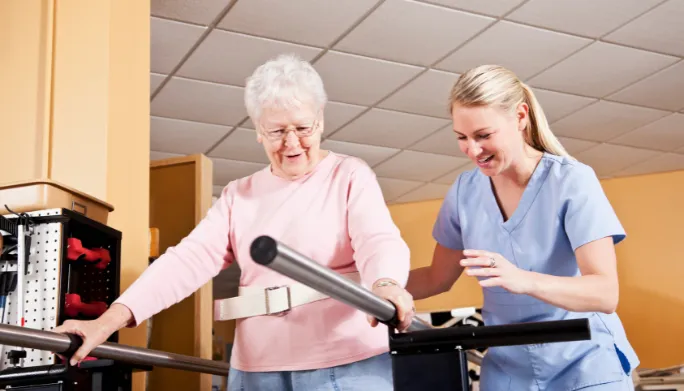Balance and Gait Disorders in Hayden
Tackle Balance and Gait Issues in Hayden
Do you freeze mid-step terrified to complete a turn fearful of falling? Or does simply standing to reach a kitchen cabinet cause the room to suddenly spin uncontrollably? You are not alone. Millions suffer balance challenges impacting confidence and independence instrumentally directing rehabilitation. The specialized neurological physical therapists at We Care Wellness Center facilitate life-changing mobility improvements for people battling equilibrium and stability issues stemming from the inner ear, brain, or nerve-based diseases through tailored treatment plans fully customizing interventions to meet patients’ unique symptom profiles and activity goals.

What Disorders Commonly Disrupt Balance and Walking?
Multiple intricate structures spanning from the inner ear up to brain motor control centers coordinate to execute smooth balancing reactions and rhythmic alternating gait sequences. Dysfunction at one or multiple points along this network disrupts stability desperately needed to prevent falls.
Some frequent balance disorder causes include:
- Parkinson’s Disease – Gradual loss of dopamine-releasing neurons causes worsening rigidity/bradykinesia
- Stroke – Loss of nervous system pathways coordinating symmetrical movement arising suddenly
- Multiple Sclerosis – Damage to nerve fibers alters messaging critical for motor planning/postural reflexes
- Traumatic Brain Injury – Concussive impacts create diffuse axonal signaling dysfunction
Pinpointing specific mobility dysfunctional allows therapists to implement targeted rehabilitation strategies and equipment optimizing recovery potential to maximize independence with walking and equilibrium.
Comprehensive Mobility and Balance Assessments
Clarifying current capability deficits and safety risks guides customized treatment plans reinforcing missing links in each patient’s equilibrium control network through repetition of challenging skills.
We thoroughly examine factors like:
- Gait – Pace, step length, symmetry, endurance, balance reactions
- Leg Strength – Test muscular endurance for transitions like standing from sitting predicting fall likelihood
- Assistive Devices – Evaluate appropriate walking aids to remove anxiety improving confidence
- Range of Motion – Identify flexibility limiting positions contributing to catching toes triggering trips
- Medications – Check for drugs with frequent disequilibrium side effects
Careful assessment provides objective baselines so we can demonstrate functional mobility gains in strength, flexibility, stability, and walking pace through our targeted interventions.
Customized Treatment for Enhanced Balance, Walking, and Safety
In contrast to generic physical therapy protocols, our skilled clinicians design customized treatment plans uniquely tailored to address patients’ distinct stability challenges and activity goals by combining evidence-based interventions:
- Sensorimotor Retraining Drills – Controlled perturbations in various positions recalibrate failing balance reactions through incremental intensity.
- Assistive Equipment – Lasers, weights, and parallel bars build movement pattern confidence and stability through the enhancement of sensory feedback input.
- Gait Stabilization Assistants – Forearm crutches, and canes with tips providing wider bases of support assist walking efficiency while minimizing fall risks during uneven surfaces.
- Lower Extremity Strengthening – Intrinsic foot muscle exercises, ankle isolation balancing, and quadriceps chair stands to boost coordination.
- Endurance Conditioning – Cardiovascular training prolongs walking tolerance windows correlated to community mobility independence.
We continually adjust protocols based on symptoms and progress to maximize outcomes through the consistent achievement of incremental functional milestones.
Why Specialized Therapy Matters for Balance/Gait Disorders in Hayden
Traditional rehabilitation programs taking one-size-fits-all generalized approaches often see protocols fail patients with complex neurological mobility issues. By contrast, our customized, research-backed vestibular and equilibrium deficiency-focused services facilitate superior outcomes:
- Reduced Fall Risks – Quantitative gait velocity, coordination, and balance control gains minimize tripping likelihood critical for aging populations through tailored interventions addressing root multifactorial issues.
- Improved Navigation Confidence – Ability to maintain stability during head turns, multi-directional transitional movements, and eyes closed reaching drills transfers to navigating busy environments securely.
- Enhanced Walking Independence – Smooth, symmetric measured stepping without upper extremity support requirements fulfills a critical facet of community mobility essential for access to social functions and errands enabling self-sufficiency.
- Renewed Outlook and Engagement – Embracing progressive calibrations in what’s possible through incremental mobility milestone achievements sustains optimism, hope, and activity engagement despite chronic diseases.
FAQs: Balance and Gait Disorder Questions
What neurological conditions frequently cause walking difficulties?
Spinal cord injury, traumatic brain injury, Parkinson’s disease, cerebral palsy, multiple sclerosis, and stroke often negatively impact gait stability from damage to fiber tracts communicating between coordination processing centers of the basal ganglia region up to descending motor output signals of the cortex and peripheral nerves exiting the spine.
What is the most common gait disturbance issue?
Neurogenic-related immobility frequently produces a wide-based, slow, shuffling pattern with minimal limb elevation and occasional freezing as sensory signals fail to efficiently transmit intact movement sequences from the brain directing muscles to smoothly alternate stepping in a predictive feedforward manner necessary for timely weight shifting and fluent walking.
What factors contribute to imbalance episodes or generally unsteady walking?
Inner ear dysfunction provoking distorted environmental perceptions, neuropathy tingling throwing off proprioceptive feedback essential for foot positioning accuracy, muscle weakness interrupting supporting joint integrity, poor vision-obscuring hazard awareness, and medication side effects all potentially tip the delicate equilibrium balance humans possess making smooth mobility easily disrupted.
Start Reclaiming Your Confidence Today
Don’t endure another day overwhelmed by the unpredictability of debilitating dizzy spells or stumbles derailing your mobility, freedom, and independence. The neurological rehabilitation experts at We Care Wellness Center leverage personalized, progressively challenging balance and gait retraining protocols proven to resolve the root causes of equilibrium and stability loss from neurological diseases or aging.
Request an appointment to take control again or call us to speak with a therapist about maximizing your mobility potential through customized vestibular, strength, and sensory integration training today!
About The Author
{Author_Name} ignites movement in patients facing {Author_Specialties}. Their dedication unlocks physical potential for a better quality of life. At We Care Wellness Center in Hayden, {Author_Name} wields a patient-centered approach, wielding cutting-edge techniques and bespoke care plans to conquer a vast array of physical challenges.
Schedule Your Evaluation in Hayden for Balance and Gait Treatment
Ready to determine if tailored therapy may hold the keys to resolving your lingering mobility loss challenges for good? Call us to schedule an assessment so we can map your pathway to safely walking, turning, and bending again with certainty.



